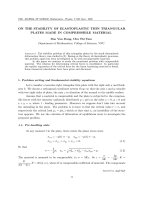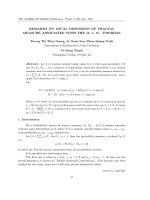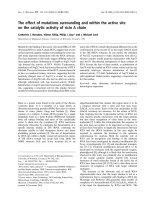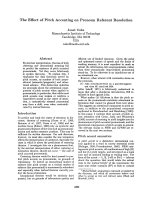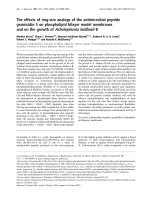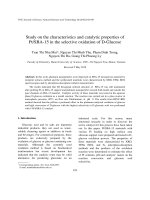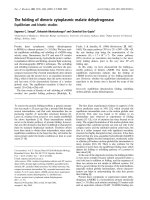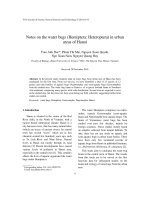Báo cáo "Reseach on the removal of hexavalent chromium from aqueous solution by iron nanoparticles " doc
Bạn đang xem bản rút gọn của tài liệu. Xem và tải ngay bản đầy đủ của tài liệu tại đây (253.04 KB, 5 trang )
VNU Journal of Science, Natural Sciences and Technology 24 (2008) 233-237
233
Reseach on the removal of hexavalent chromium from
aqueous solution by iron nanoparticles
Nguyen Thi Nhung*, Nguyen Thi Kim Thuong
Institute of Geological Sciences, Vietnamese Academy of Science and Technology
84 Chua Lang, Dong Da, Hanoi, Vietnam
Received 15 August 2007
Abstract. Groundwater remediation by nanoparticles has become a major interest in recent years.
This report presents the ability of hexavalent chromium removal in aqueous using iron (Fe
0
)
nanoparticles. Cr(VI) is a major pollution of groundwater and more toxic than Cr(III). Fe
0
reduces
Cr(VI), transforming Cr(VI) to nontoxic Cr(III). At a dose of 0.2g/l iron (Fe
o
) nanoparticles, 100%
of Cr(VI) 5mg/l was removed after only 20 minutes. The Cr(VI) removal efficiency increased with
decreasing initial pH. Synthesized Fe
0
nanoparticles were compared iron powder in the same
conditions. The results show that Fe
0
nanoparticles are more efficient than Fe powder. The final
product of the reduction process Cr(VI) was Cr(OH)
3
. It was concluded that iron nanoparticles are
a good choice for the removal of heavy metals in water.
1. Introduction
∗
∗∗
∗
Cr(VI) is toxic, carcinogenic to human and
animals. Cr(VI) is commonly found in water,
soil and industry waste water. In contrast,
Cr(III) is much less toxic and immobile and can
be a nutriement for human and animals. So, the
removal method of Cr(VI) is to reduce Cr(VI)
to Cr(III)[1,2]. Many other removal methods
for Cr(VI) in water has been proposed, such as
physio-chemical adsorption, bioremediation,
chemical reduction [3-5]. However, the cost of
physio-chemical adsorption method is high and
the removal is not complete when
bioremediation is not suitable for waste water.
Chemical reduction is known to remove Cr(VI)
_______
∗
Corresponding author. Tel.: 84-4-8582331.
E-mail:
rapidly and effectively. Many reductants were
employed such as H
2
S. Fe
2+
, Fe
0
. ect. In this
report, we use iron nanoparticles (Fe
0
) to
reduce Cr(VI) to Cr(III), iron nanoparticles
(Fe
0
) was sythesized by us. The reactions of
Cr(VI) reduction and coprecipitation of Cr(III)
and Fe(III) are:
CrO
4
2-
+ Fe
0
+ 8H
+
= Fe
3+
+ Cr
3+
+ 4H
2
O (1)
(1-x)Fe
3+
+ xCr
3+
+ 2H
2
O
= Fe
(1-x)
Cr
x
OOH
S
+
3H
+
(2)
The main objective of this work is to
prepare Fe
0
nanoparticles for the removal of
Cr(VI). The specific objectives are to (1)
characterization of Fe
0
nanoparticles, (2) the
effect of initial pH on the rate of Cr(VI)
reduction, (3) the effect of Cr(VI)
concentration, (4) the effect of Fe
0
nanoparticles dosage, (5) compare the
N.T. Nhung, N.T. Kim Thuong / VNU Journal of Science, Natural Sciences and Technology 24 (2008) 233-237
234
effectiveness of Cr(VI) reduction by nanoiron
and iron powder.
2. Materials and methods
2.1. Chemical
- All chemical reagents, such as
FeSO
4
.7H
2
O, K
2
CrO
7
, H
2
SO
4
, NaBH
4
are pure
analyst (p.a).
- Deionized water was used for preparing
all solutions.
- The Fe
0
nanoparticles were synthesized
before use. The Fe
0
nanoparticles were
synthesized by dropwise addition of NaBH
4
aqueous solution into 1000ml flash containing
FeSO
4
.7H
2
O aqueous solution simultaneously
with electrical stirring. The ferrous iron was
reduced to zero-valent iron according to the
following reaction:
Fe(H
2
O)
6
2+
+ 2BH
4
-
→ Fe
0
↓ +2B(OH)
3
+
7H
2
↑ (3)
The Fe
0
nanoparticles were then rinsed 3-4
times with deionized water and dried in vacuum
drier at the temperature of 30C overnight.
2.2. Experiments
The experiments for the reduction of Cr(VI)
was performed in 1000 ml flash, Cr(VI)
aqueous solution was added into the flash
containing iron nanoparticles. The reaction
solution was stirred. After that, the sample was
filtered through 0.2µm membrane filters for
analysis. The effect of various parameters on
the Cr(VI) reduction was researched.
2.3. Analytical methods
Cr(VI) was determined spectrophotometrically
with diphenylcarbazide at 540 nm using UV-
VIS spectrophotometer (china).
3. Results and discussion
3.1. Characterization of Fe
0
nanoparticles
Transmission electron microscopy (TEM)
images were obtained on a JEOL 1010 EM of
operating at 100kV.
Fig.1. TEM image of iron nanoparticsls.
The size and size distribution of iron
nanoparticles were characterized by TEM. Fig.1
show that the particles are in the range 3-50nm
diameter and particles are spherical and form
chains of beads. This type of aggregation due to
magnetic interraction between the iron particles.
Similar phenomenon was observed by other
researchers[1,2,6,7]. The specific surface area
of iron nanoparticles was 25,43 m
2
/g.
3.2. Effect of the intial pH on the rate of Cr(VI)
reduction
Experimental conditions: Fe
0
dosage 0,1g/l,
Cr(VI) 2.0mg/l, changing pH from 2.5 to 8. The
reaction solution was stirred about ten minutes.
After that, the sample was filtered through
0.2µm membrane filters for analysis. The
results is shown in the Fig.2.
N.T. Nhung, N.T. Kim Thuong / VNU Journal of Science, Natural Sciences and Technology 24 (2008) 233-237
235
0
20
40
60
80
100
120
2 3 4 5 6 7 8 9
pH
%Cr(VI) treatment
Fig. 2. Effect of the intial pH value on the rate of
Cr(VI) reduction.
Fig. 2 show that, the Cr(VI) removal
efficiency increased with decreasing pH. When
pH value from 2,5 to 5 removal efficiency is
high, when pH > 8 removal efficiency
decreased rapidly because of the formation of
Fe(OH)
3
during high pH value.
3.3.Effect of initial Cr(VI) concentration
Experimental conditions: Fe
0
dosage =
0,1g/l, pH = 4-5, Cr(VI) concentration from 1-
5.0mg/l. The reaction solution was stirred
continuously and samples were taken
periodically, the sample was then filtered
through 0.2µm membrane filters for analysis.
The results are shown the Fig. 3
0
0.2
0.4
0.6
0.8
1
1.2
0 10 20 30 40 50 60
Time(min)
[Cr(VI)]/[Cr(VI)]
0
Cr(VI) = 1.0 mg/l
Cr(VI) = 2.0 mg/l
Cr(VI) = 3.0 mg/l
Cr(VI) = 4.0 mg/l
Cr(VI) = 5.0 mg/l
Fig. 3. Effect of initial Cr(VI) concentration on the
rate of Cr(VI) removal efficiency.
Fig. 3 shows the results of effect of initial
Cr(VI) concentration on the rate of Cr(VI)
removal with the initial Cr(VI) concentration
from 1.0 mg/l to 5.0 mg/l. The Cr(VI) removal
efficiency increased inversely with the
concentration of initial Cr(VI). After 20 minutes,
the removal is 100% at concentration of 2mg/l
and 69.32% at concentration of 5mg/l. When
treatment time increased then Cr(VI) removal
efficiency decreased. The proper mass ratio of
Fe nanoparticles to Cr(VI) was about 50:1.
3.4. Effect of iron nanoparticles concentration
Experimental conditions pH = 4-5, Cr(VI)
concentration = 5.0mg/l, changing iron
nanaparticle concentration from 0.1 g/l to
0.3g/l. The reaction solution was stirred
continuously and sample was taken at regular
interval. After that, the sample was filtered
through 0.2µm membrane filters for analysis
then Cr(VI) concentration is determined. The
results are shown the Fig. 4
0
0.2
0.4
0.6
0.8
1
1.2
0 20 40 60
Time(min)
[Cr(VI)]/[Cr(VI)]0
Nano Fe = 0,1g/l
Nano Fe = 0.15g/l
Nano Fe = 0.2g/l
Nano Fe = 0.25g/l
Nano Fe = 0.3g/l
Fig. 4. Effect of iron nanoparticals concentration.
Fig. 4 shows that, Cr(VI) removal efficiency
increased with Fe
0
concentration. When the Fe
0
concentration was 0.3g/l, after 10 minutes,
100% Cr(VI) of concentration 5mg/l was
removed. When the Fe
0
concentration was
0.1g/l, after 10 minutes, only 62.68% Cr(VI)
was removed, after 30 minutes, 76.72% Cr(VI)
was removed, and after 60 minutes, 82.54%
Cr(VI) concentration was removed. Cr(VI)
N.T. Nhung, N.T. Kim Thuong / VNU Journal of Science, Natural Sciences and Technology 24 (2008) 233-237
236
concentration decreased rapidly in the initial ten
minutes, then slow down afterwards.
3.5. Comparison of the effectiveness of Cr(VI)
reduction by nanoiron and power iron.
Experimental conditions: pH = 4-5, Cr(VI)
concentration = 2.0mg/l, iron powder mass
0.1g. The other condition was similar over 4.
The results show the Fig.5.
0
0.2
0.4
0.6
0.8
1
1.2
0 10 20 30 40 50 60
Time(min)
[Cr(VI)]/Cr(VI)]0
Fe powder
Fe nanoparticals
Fig. 5. Comparison of different Fe
0
type on the
Cr(VI) removal efficiency.
Fig. 5 show that Cr(VI) removal efficiency
of nanoparticles was higher than Fe powder
about 4 times. Namely, after 10 minutes, 98.8%
Cr(VI) concentration was removed by iron
nanoparticals, while only 24.75% Cr(VI)
concentration was removed by iron powder.
4. Conclusion
The removal of Cr(VI) by Fe
0
nanoparticles
was studied, the concentration of Fe
0
nanoparticles had effect on the reduction of
Cr(VI). When the mass ratio of Fe
0
to Cr(VI)
was 50:1, 100% removal efficency was
achieved. pH has important effect on Cr(VI)
removal efficiency, the optimal pH was from
2.5 to 5. Cr(VI) removal efficiency by iron
nanoparticles was 4 times higher than iron
powder. As the results, the iron nanoparticles
was used to remove Cr(VI) in aqueous solution
with high efficency.
References
[1] NIU Shao-feng, LIU Yong, XU Xin-hua, LOU
Zhang-hua, Removal of hexavalent chromium
from aqueous solution by iron nanoparticles,
Journal of Zhejiang University SCIENCE 6B,
10 (2005) 1022.
[2] M. Ponder Sherman, G. Darab John, E. Mallouk
Thomas, Remediation of Cr(VI) and Pb(II)
Aqueous Solutions Using Supported, Nanoscale
Zero-valent Iron, Environ. Sci. Technol. 34
(2000) 2564.
[3] R.S. Bowman, Applications of surfactant-
modified zeolites to environmental remediation.
Microporous and Mesoporous Materials 61
(2003) 43.
[4] J.M. Chen, O.J. Hao, Microbial chromium(VI)
reduction.Critical Rev. Environmental Science
Technology 28 (1998) 219.
[5] B. Hua, B. Deng, Influences of water vapor on
Cr(VI) reduction by gaseous hydrogen sulfide.
Environmental Science Technology, 37 (2003)
4771.
[6] M. Ponder Sherman, G. Darab John, Jerome
Bucher, Dana Caulder, Ian Craig, Linda Davis,
Norman Edelstein, Wayne Lukens, Heino
Nitsche, Linfeng Rao, K. Shuh David, E.
Mallouk Thomas, Surface Chemistry and
Electrochemistry of Supported Zerovalent Iron
Nanoparticles in the Remediation of Aqueous
Metal Contaminants, Chem. Mater., Vol. 13, No.
2, 2001.
[7] Taeyoon Lee, Hyunjung Lim, Yonghun Lee,
Jae-Woo Park, Use of waste iron metal for
removal of Cr(VI) from water, Chemosphere 53
(2003) 479.
N.T. Nhung, N.T. Kim Thuong / VNU Journal of Science, Natural Sciences and Technology 24 (2008) 233-237
237
Nghiên cứu khả năng loại Cr(VI) trong dung dịch nước
bằng nano sắt
Nguyễn Thị Nhung, Nguyễn Thị Kim Thường
Viện ðịa chất, Viện Khoa học và Công nghệ Việt Nam
84 Chùa Láng, ðống ða, Hà Nội, Việt Nam
Trong những năm gần ñây thì việc xử lý nước ngầm bằng các hạt có kích thước nano ngày càng
ñược quan tâm. Trong bài báo này, chúng tôi ñã nghiên cứu tách loại Cr(VI) bằng nano sắt tổng hợp
ñược. Cr(VI) là một chất ñộc, ñộc hơn Cr(III). Cr(VI) thường bị ô nhiễm trong nước ngầm, nhất là
những vùng có các khu công nghiệp. Do vậy, phương pháp khử Cr(VI) về Cr(III) ñược sử dụng ñể loại
Cr(VI). Kết quả nghiên cứu cho thấy, 100% Cr(VI) hàm lượng 2.0mg/l ñược loại hoàn toàn sau 20
phút khi hàm lượng Fe
0
là 0.1 g/l. Dung lượng hấp phụ tăng khi hàm lượng Cr(VI) ban ñầu tăng. pH
tối ưu loại Cr(VI) từ 2.5 ñến 5, khi pH lớn hơn 8 thì hiệu quả loại Cr(VI) giảm mạnh do nano sắt tạo
thành Fe(OH)
3
. Khả năng loại Cr(VI) bằng nano sắt ñược so sánh với bột sắt thương mại, kết quả cho
thấy hiệu quả loại Cr(VI) bằng nano sắt cao gấp bốn lần. Thời gian là một trong những yếu tố ảnh
hưởng rõ rệt ñến hiệu quả tách loại Cr(VI) ra khỏi dung dịch, tốc ñộ phản ứng loại Cr(VI) xảy ra rất
nhanh trong 10 phút ñầu, sau ñó tốc ñộ giảm dần và bão hoà do hỗn hợp Cr(OH)
3
bám lên bề mặt hạt
sắt. Sản phẩm cuối cùng của phản ứng khử Cr(VI) là Cr(OH)
3
. Từ những kết quả thu ñược cho thấy,
hạt nano sắt có khả năng loại Cr(VI) ra khỏi dung dịch nước hiệu quả cao, nhanh, chất cặn ít, thân
thiện với môi trường.
